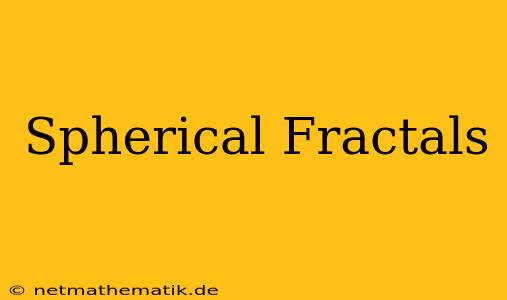The exploration of fractals has captivated mathematicians, physicists, and artists alike, revealing intricate patterns and surprising complexities within seemingly simple structures. Among the myriad forms fractals can take, spherical fractals stand out as captivating geometric marvels. These three-dimensional structures, often resembling intricately patterned orbs, exhibit self-similarity, a hallmark of fractals, across multiple scales. This article delves into the fascinating world of spherical fractals, exploring their mathematical origins, diverse examples, and potential applications.
The Mathematical Foundation of Spherical Fractals
The mathematical foundation of spherical fractals lies in iterative processes applied to spheres. These processes, often described by recursive algorithms, involve repeated transformations on an initial spherical shape. The transformations can include:
- Scaling: Enlarging or shrinking the sphere, creating smaller or larger copies of itself.
- Rotation: Rotating the sphere around its center, altering its orientation.
- Translation: Moving the sphere along a certain direction, shifting its position in space.
The repeated application of these transformations, often with slight variations in their parameters, generates increasingly complex and intricate spherical fractal structures.
Iterative Processes in Fractal Generation
To visualize the iterative process in action, consider the simple case of a spherical fractal generated by repeatedly dividing the sphere into smaller spheres. Starting with a single sphere, each iteration divides each sphere into a fixed number of smaller spheres, often arranged in a symmetrical pattern. This process is repeated ad infinitum, resulting in an infinitely detailed structure.
Diverse Examples of Spherical Fractals
The beauty of spherical fractals lies in their diversity. From the classic Menger sponge to more exotic examples like the Sierpinski sphere, the range of spherical fractal structures is vast and continues to inspire mathematicians and artists.
Menger Sponge: A Classic Example
The Menger sponge, a three-dimensional analogue of the Sierpinski triangle, exemplifies the principle of self-similarity. The construction process involves repeatedly dividing a cube into smaller cubes, then removing the center cube and any cubes sharing a face with the center cube. This process is repeated for each remaining cube, leading to a structure with an infinite surface area but a finite volume.
Sierpinski Sphere: An Intricate Construction
The Sierpinski sphere, a three-dimensional extension of the Sierpinski triangle, is constructed by repeatedly dividing an octahedron into smaller octahedra and removing the center octahedron and all octahedra that share a face with it. This process generates a highly intricate structure with a fractal dimension greater than 2 but less than 3.
Applications of Spherical Fractals
The intriguing properties of spherical fractals extend beyond their mathematical elegance and aesthetic appeal. They find applications in diverse fields, including:
Antenna Design: Enhancing Signal Transmission
The intricate surface structure of spherical fractals offers potential applications in antenna design. The fractal geometry can enhance the efficiency of signal transmission and reception, potentially leading to improved performance in communication systems.
Materials Science: Designing Novel Materials
The self-similarity of spherical fractals suggests their potential in designing novel materials with unique properties. For example, spherical fractal structures can influence the surface area and porosity of materials, potentially enhancing their catalytic properties or their ability to absorb energy.
Computer Graphics: Creating Realistic Textures
The intricate details of spherical fractals offer a powerful tool for generating realistic textures in computer graphics. Their self-similar patterns and complex surface structures can create visually stunning effects, adding a layer of depth and complexity to virtual worlds.
Conclusion: Exploring the Infinite Complexity of Spherical Fractals
The world of spherical fractals offers a fascinating glimpse into the infinite complexity of geometric structures. From their mathematical foundations to their diverse forms and potential applications, spherical fractals continue to challenge our understanding of the world around us. As research into spherical fractals continues, we can expect to uncover even more captivating properties and surprising applications for these intriguing objects.
